Asda: Business Resources, Finance, and Performance Analysis Report
VerifiedAdded on 2020/06/05
|10
|2870
|141
Report
AI Summary
This report provides a comprehensive analysis of Asda's business resources, including recruitment documentation, employability skills, physical and technological resources, and sources of finance. It details the recruitment documentation used by Asda, such as job descriptions, person specifications, and application forms. The report also covers the main employability, personal, and communication skills required for specific job roles. It examines the physical and technological resources essential for Asda's operations, such as computers, software, and networking systems. Furthermore, the report explores internal and external sources of finance available to Asda, interpreting financial statements and using budgets for financial control. The report evaluates accounting ratios and their impact on Asda's performance, offering insights into profitability and financial health. The analysis underscores strategies for improving business performance through effective resource management and financial planning.
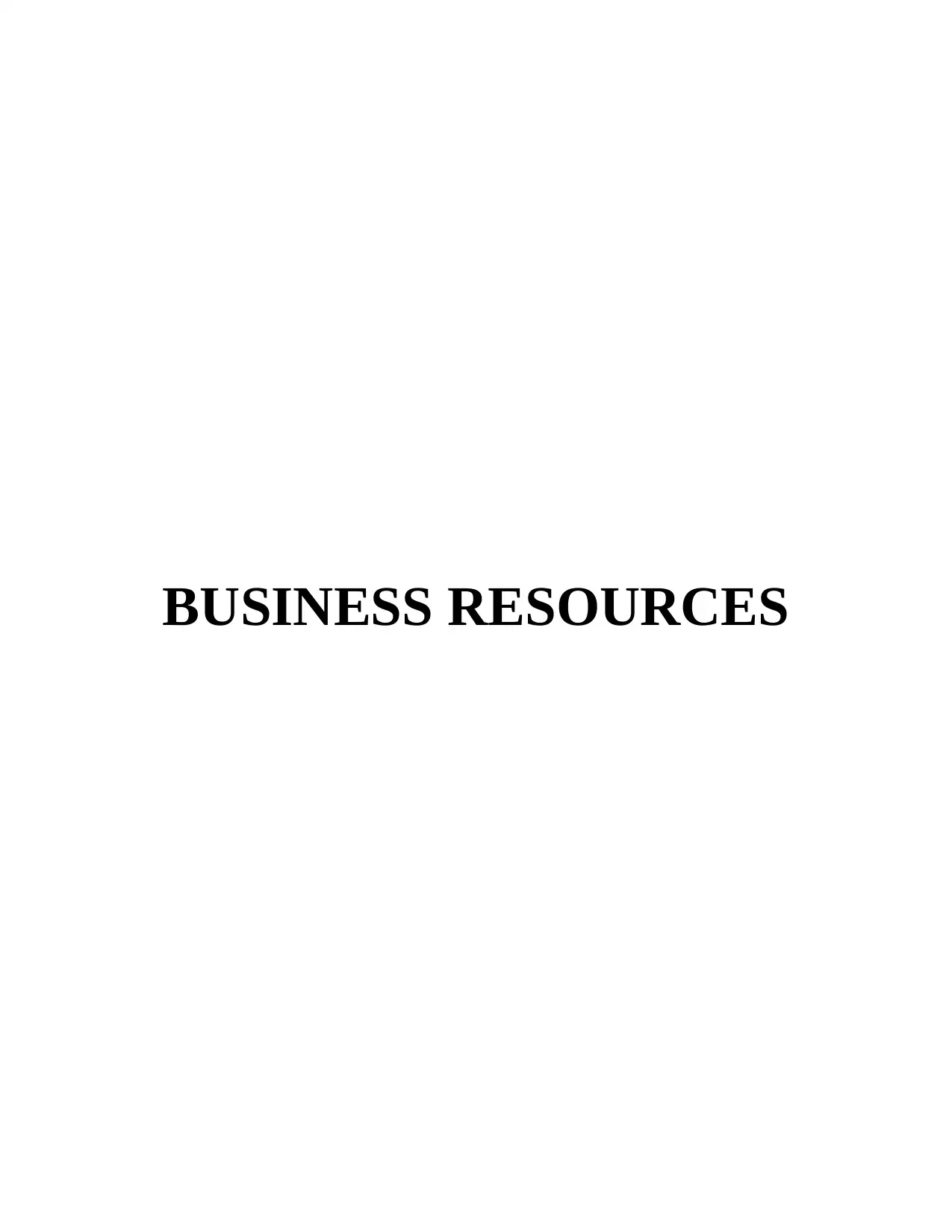
BUSINESS RESOURCES
Paraphrase This Document
Need a fresh take? Get an instant paraphrase of this document with our AI Paraphraser
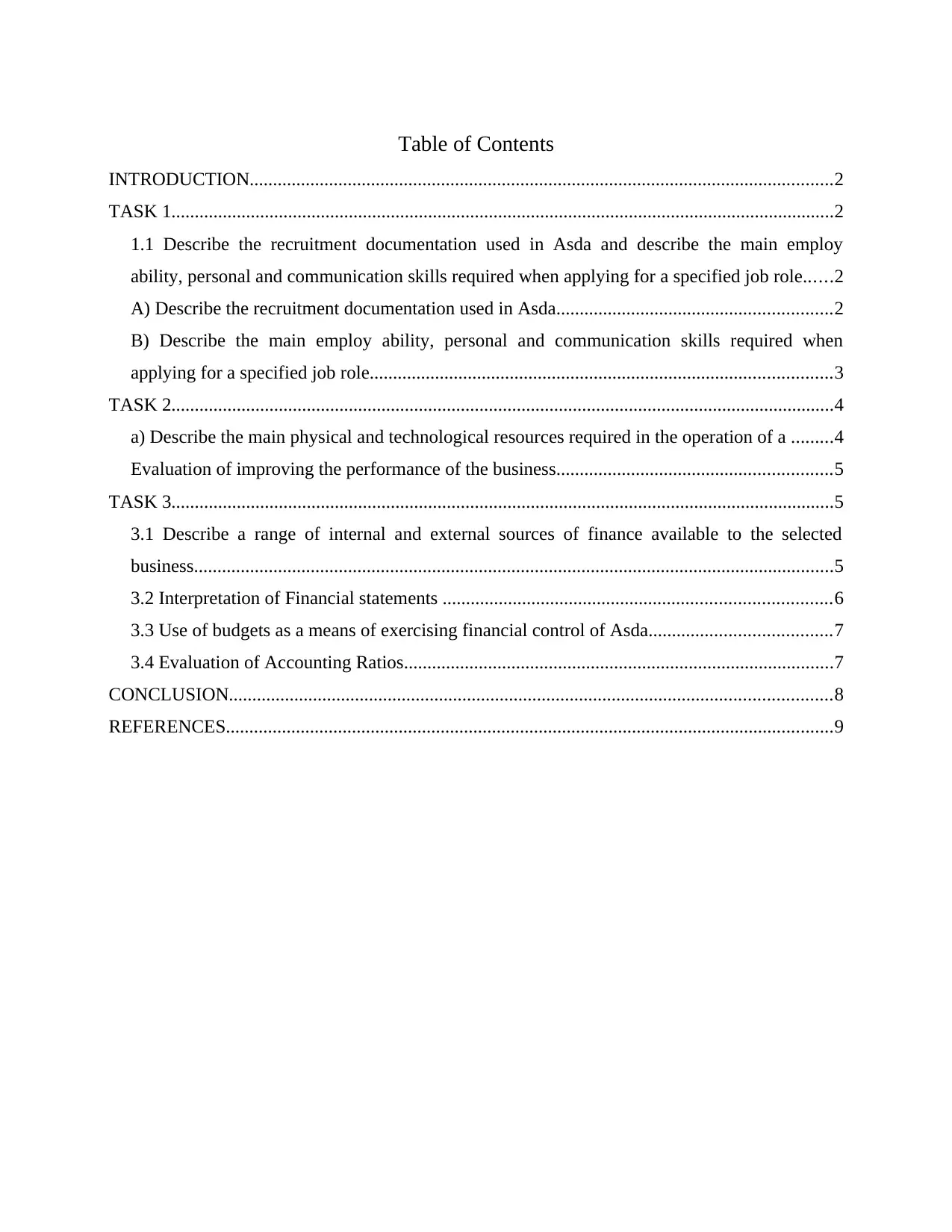
Table of Contents
INTRODUCTION.............................................................................................................................2
TASK 1..............................................................................................................................................2
1.1 Describe the recruitment documentation used in Asda and describe the main employ
ability, personal and communication skills required when applying for a specified job role......2
A) Describe the recruitment documentation used in Asda...........................................................2
B) Describe the main employ ability, personal and communication skills required when
applying for a specified job role...................................................................................................3
TASK 2..............................................................................................................................................4
a) Describe the main physical and technological resources required in the operation of a .........4
Evaluation of improving the performance of the business...........................................................5
TASK 3..............................................................................................................................................5
3.1 Describe a range of internal and external sources of finance available to the selected
business.........................................................................................................................................5
3.2 Interpretation of Financial statements ...................................................................................6
3.3 Use of budgets as a means of exercising financial control of Asda.......................................7
3.4 Evaluation of Accounting Ratios............................................................................................7
CONCLUSION.................................................................................................................................8
REFERENCES..................................................................................................................................9
INTRODUCTION.............................................................................................................................2
TASK 1..............................................................................................................................................2
1.1 Describe the recruitment documentation used in Asda and describe the main employ
ability, personal and communication skills required when applying for a specified job role......2
A) Describe the recruitment documentation used in Asda...........................................................2
B) Describe the main employ ability, personal and communication skills required when
applying for a specified job role...................................................................................................3
TASK 2..............................................................................................................................................4
a) Describe the main physical and technological resources required in the operation of a .........4
Evaluation of improving the performance of the business...........................................................5
TASK 3..............................................................................................................................................5
3.1 Describe a range of internal and external sources of finance available to the selected
business.........................................................................................................................................5
3.2 Interpretation of Financial statements ...................................................................................6
3.3 Use of budgets as a means of exercising financial control of Asda.......................................7
3.4 Evaluation of Accounting Ratios............................................................................................7
CONCLUSION.................................................................................................................................8
REFERENCES..................................................................................................................................9
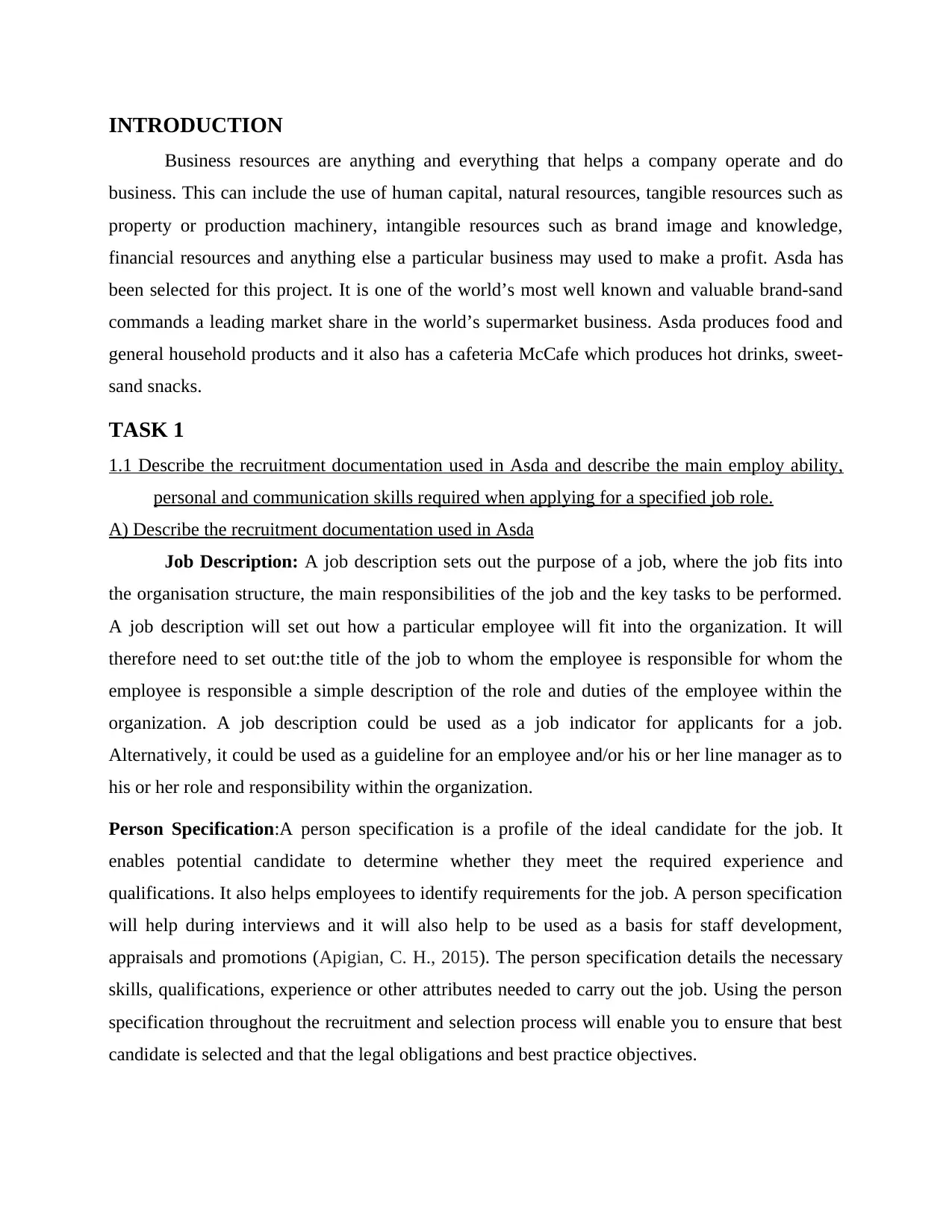
INTRODUCTION
Business resources are anything and everything that helps a company operate and do
business. This can include the use of human capital, natural resources, tangible resources such as
property or production machinery, intangible resources such as brand image and knowledge,
financial resources and anything else a particular business may used to make a profit. Asda has
been selected for this project. It is one of the world’s most well known and valuable brand-sand
commands a leading market share in the world’s supermarket business. Asda produces food and
general household products and it also has a cafeteria McCafe which produces hot drinks, sweet-
sand snacks.
TASK 1
1.1 Describe the recruitment documentation used in Asda and describe the main employ ability,
personal and communication skills required when applying for a specified job role.
A) Describe the recruitment documentation used in Asda
Job Description: A job description sets out the purpose of a job, where the job fits into
the organisation structure, the main responsibilities of the job and the key tasks to be performed.
A job description will set out how a particular employee will fit into the organization. It will
therefore need to set out:the title of the job to whom the employee is responsible for whom the
employee is responsible a simple description of the role and duties of the employee within the
organization. A job description could be used as a job indicator for applicants for a job.
Alternatively, it could be used as a guideline for an employee and/or his or her line manager as to
his or her role and responsibility within the organization.
Person Specification:A person specification is a profile of the ideal candidate for the job. It
enables potential candidate to determine whether they meet the required experience and
qualifications. It also helps employees to identify requirements for the job. A person specification
will help during interviews and it will also help to be used as a basis for staff development,
appraisals and promotions (Apigian, C. H., 2015). The person specification details the necessary
skills, qualifications, experience or other attributes needed to carry out the job. Using the person
specification throughout the recruitment and selection process will enable you to ensure that best
candidate is selected and that the legal obligations and best practice objectives.
Business resources are anything and everything that helps a company operate and do
business. This can include the use of human capital, natural resources, tangible resources such as
property or production machinery, intangible resources such as brand image and knowledge,
financial resources and anything else a particular business may used to make a profit. Asda has
been selected for this project. It is one of the world’s most well known and valuable brand-sand
commands a leading market share in the world’s supermarket business. Asda produces food and
general household products and it also has a cafeteria McCafe which produces hot drinks, sweet-
sand snacks.
TASK 1
1.1 Describe the recruitment documentation used in Asda and describe the main employ ability,
personal and communication skills required when applying for a specified job role.
A) Describe the recruitment documentation used in Asda
Job Description: A job description sets out the purpose of a job, where the job fits into
the organisation structure, the main responsibilities of the job and the key tasks to be performed.
A job description will set out how a particular employee will fit into the organization. It will
therefore need to set out:the title of the job to whom the employee is responsible for whom the
employee is responsible a simple description of the role and duties of the employee within the
organization. A job description could be used as a job indicator for applicants for a job.
Alternatively, it could be used as a guideline for an employee and/or his or her line manager as to
his or her role and responsibility within the organization.
Person Specification:A person specification is a profile of the ideal candidate for the job. It
enables potential candidate to determine whether they meet the required experience and
qualifications. It also helps employees to identify requirements for the job. A person specification
will help during interviews and it will also help to be used as a basis for staff development,
appraisals and promotions (Apigian, C. H., 2015). The person specification details the necessary
skills, qualifications, experience or other attributes needed to carry out the job. Using the person
specification throughout the recruitment and selection process will enable you to ensure that best
candidate is selected and that the legal obligations and best practice objectives.
⊘ This is a preview!⊘
Do you want full access?
Subscribe today to unlock all pages.

Trusted by 1+ million students worldwide
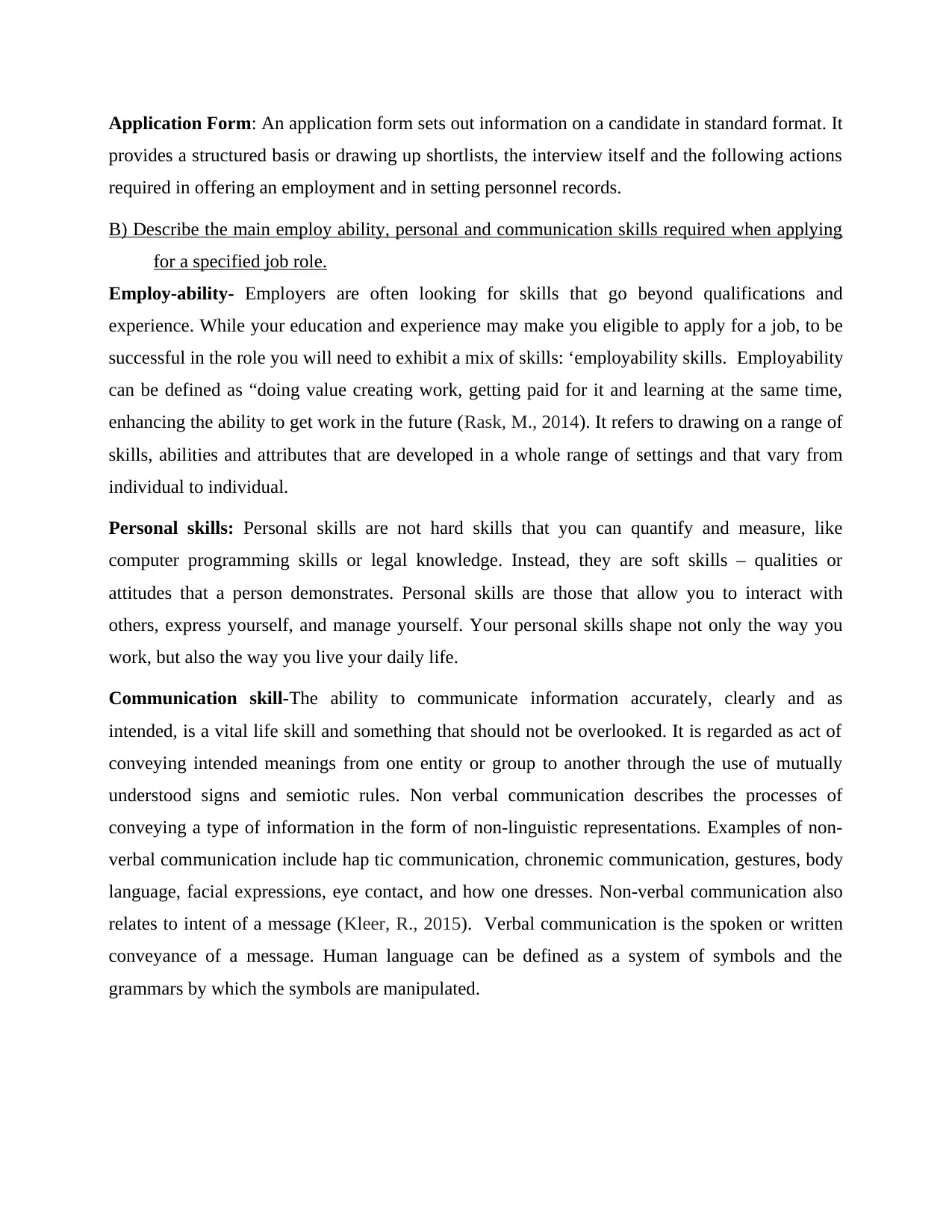
Application Form: An application form sets out information on a candidate in standard format. It
provides a structured basis or drawing up shortlists, the interview itself and the following actions
required in offering an employment and in setting personnel records.
B) Describe the main employ ability, personal and communication skills required when applying
for a specified job role.
Employ-ability- Employers are often looking for skills that go beyond qualifications and
experience. While your education and experience may make you eligible to apply for a job, to be
successful in the role you will need to exhibit a mix of skills: ‘employability skills. Employability
can be defined as “doing value creating work, getting paid for it and learning at the same time,
enhancing the ability to get work in the future (Rask, M., 2014). It refers to drawing on a range of
skills, abilities and attributes that are developed in a whole range of settings and that vary from
individual to individual.
Personal skills: Personal skills are not hard skills that you can quantify and measure, like
computer programming skills or legal knowledge. Instead, they are soft skills – qualities or
attitudes that a person demonstrates. Personal skills are those that allow you to interact with
others, express yourself, and manage yourself. Your personal skills shape not only the way you
work, but also the way you live your daily life.
Communication skill-The ability to communicate information accurately, clearly and as
intended, is a vital life skill and something that should not be overlooked. It is regarded as act of
conveying intended meanings from one entity or group to another through the use of mutually
understood signs and semiotic rules. Non verbal communication describes the processes of
conveying a type of information in the form of non-linguistic representations. Examples of non-
verbal communication include hap tic communication, chronemic communication, gestures, body
language, facial expressions, eye contact, and how one dresses. Non-verbal communication also
relates to intent of a message (Kleer, R., 2015). Verbal communication is the spoken or written
conveyance of a message. Human language can be defined as a system of symbols and the
grammars by which the symbols are manipulated.
provides a structured basis or drawing up shortlists, the interview itself and the following actions
required in offering an employment and in setting personnel records.
B) Describe the main employ ability, personal and communication skills required when applying
for a specified job role.
Employ-ability- Employers are often looking for skills that go beyond qualifications and
experience. While your education and experience may make you eligible to apply for a job, to be
successful in the role you will need to exhibit a mix of skills: ‘employability skills. Employability
can be defined as “doing value creating work, getting paid for it and learning at the same time,
enhancing the ability to get work in the future (Rask, M., 2014). It refers to drawing on a range of
skills, abilities and attributes that are developed in a whole range of settings and that vary from
individual to individual.
Personal skills: Personal skills are not hard skills that you can quantify and measure, like
computer programming skills or legal knowledge. Instead, they are soft skills – qualities or
attitudes that a person demonstrates. Personal skills are those that allow you to interact with
others, express yourself, and manage yourself. Your personal skills shape not only the way you
work, but also the way you live your daily life.
Communication skill-The ability to communicate information accurately, clearly and as
intended, is a vital life skill and something that should not be overlooked. It is regarded as act of
conveying intended meanings from one entity or group to another through the use of mutually
understood signs and semiotic rules. Non verbal communication describes the processes of
conveying a type of information in the form of non-linguistic representations. Examples of non-
verbal communication include hap tic communication, chronemic communication, gestures, body
language, facial expressions, eye contact, and how one dresses. Non-verbal communication also
relates to intent of a message (Kleer, R., 2015). Verbal communication is the spoken or written
conveyance of a message. Human language can be defined as a system of symbols and the
grammars by which the symbols are manipulated.
Paraphrase This Document
Need a fresh take? Get an instant paraphrase of this document with our AI Paraphraser
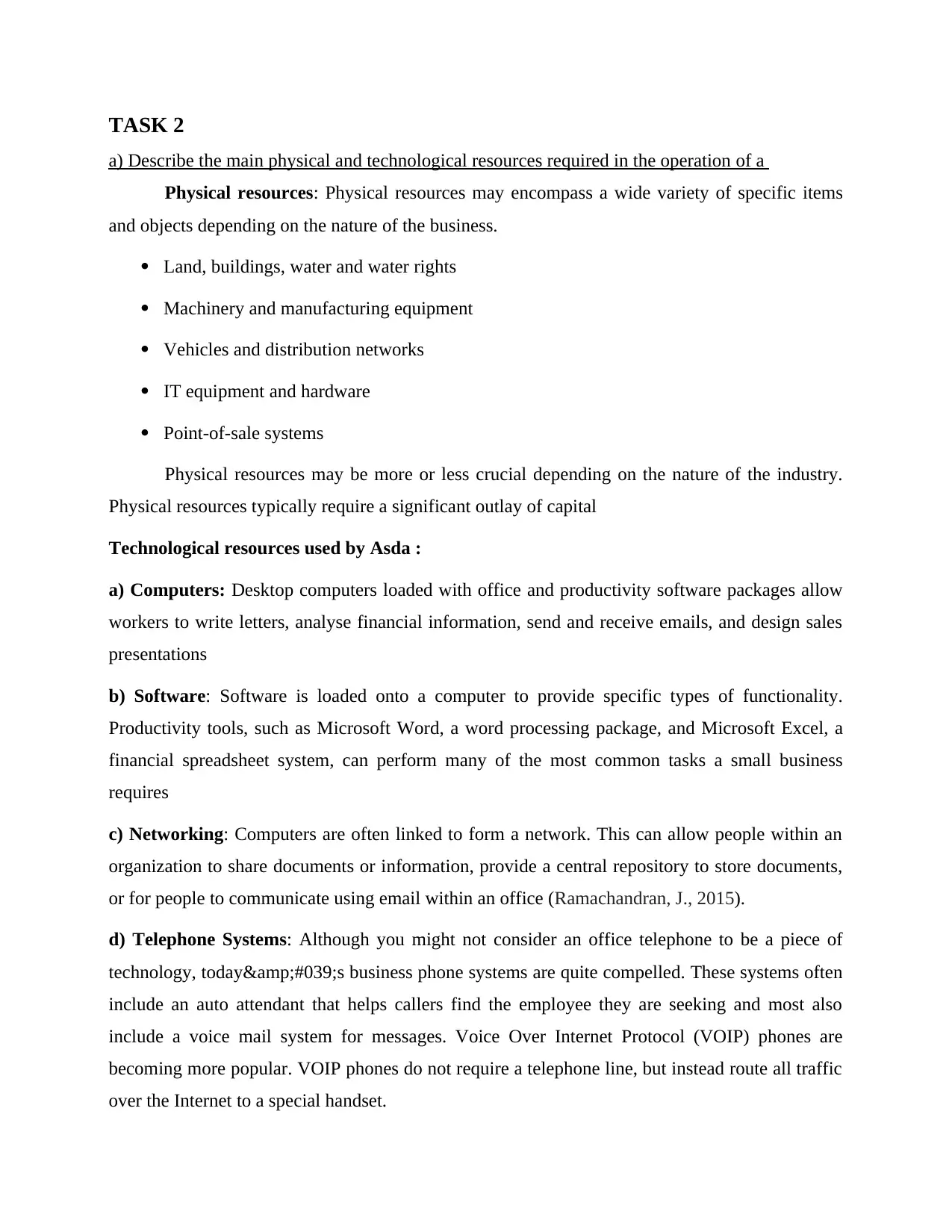
TASK 2
a) Describe the main physical and technological resources required in the operation of a
Physical resources: Physical resources may encompass a wide variety of specific items
and objects depending on the nature of the business.
Land, buildings, water and water rights
Machinery and manufacturing equipment
Vehicles and distribution networks
IT equipment and hardware
Point-of-sale systems
Physical resources may be more or less crucial depending on the nature of the industry.
Physical resources typically require a significant outlay of capital
Technological resources used by Asda :
a) Computers: Desktop computers loaded with office and productivity software packages allow
workers to write letters, analyse financial information, send and receive emails, and design sales
presentations
b) Software: Software is loaded onto a computer to provide specific types of functionality.
Productivity tools, such as Microsoft Word, a word processing package, and Microsoft Excel, a
financial spreadsheet system, can perform many of the most common tasks a small business
requires
c) Networking: Computers are often linked to form a network. This can allow people within an
organization to share documents or information, provide a central repository to store documents,
or for people to communicate using email within an office (Ramachandran, J., 2015).
d) Telephone Systems: Although you might not consider an office telephone to be a piece of
technology, today's business phone systems are quite compelled. These systems often
include an auto attendant that helps callers find the employee they are seeking and most also
include a voice mail system for messages. Voice Over Internet Protocol (VOIP) phones are
becoming more popular. VOIP phones do not require a telephone line, but instead route all traffic
over the Internet to a special handset.
a) Describe the main physical and technological resources required in the operation of a
Physical resources: Physical resources may encompass a wide variety of specific items
and objects depending on the nature of the business.
Land, buildings, water and water rights
Machinery and manufacturing equipment
Vehicles and distribution networks
IT equipment and hardware
Point-of-sale systems
Physical resources may be more or less crucial depending on the nature of the industry.
Physical resources typically require a significant outlay of capital
Technological resources used by Asda :
a) Computers: Desktop computers loaded with office and productivity software packages allow
workers to write letters, analyse financial information, send and receive emails, and design sales
presentations
b) Software: Software is loaded onto a computer to provide specific types of functionality.
Productivity tools, such as Microsoft Word, a word processing package, and Microsoft Excel, a
financial spreadsheet system, can perform many of the most common tasks a small business
requires
c) Networking: Computers are often linked to form a network. This can allow people within an
organization to share documents or information, provide a central repository to store documents,
or for people to communicate using email within an office (Ramachandran, J., 2015).
d) Telephone Systems: Although you might not consider an office telephone to be a piece of
technology, today's business phone systems are quite compelled. These systems often
include an auto attendant that helps callers find the employee they are seeking and most also
include a voice mail system for messages. Voice Over Internet Protocol (VOIP) phones are
becoming more popular. VOIP phones do not require a telephone line, but instead route all traffic
over the Internet to a special handset.
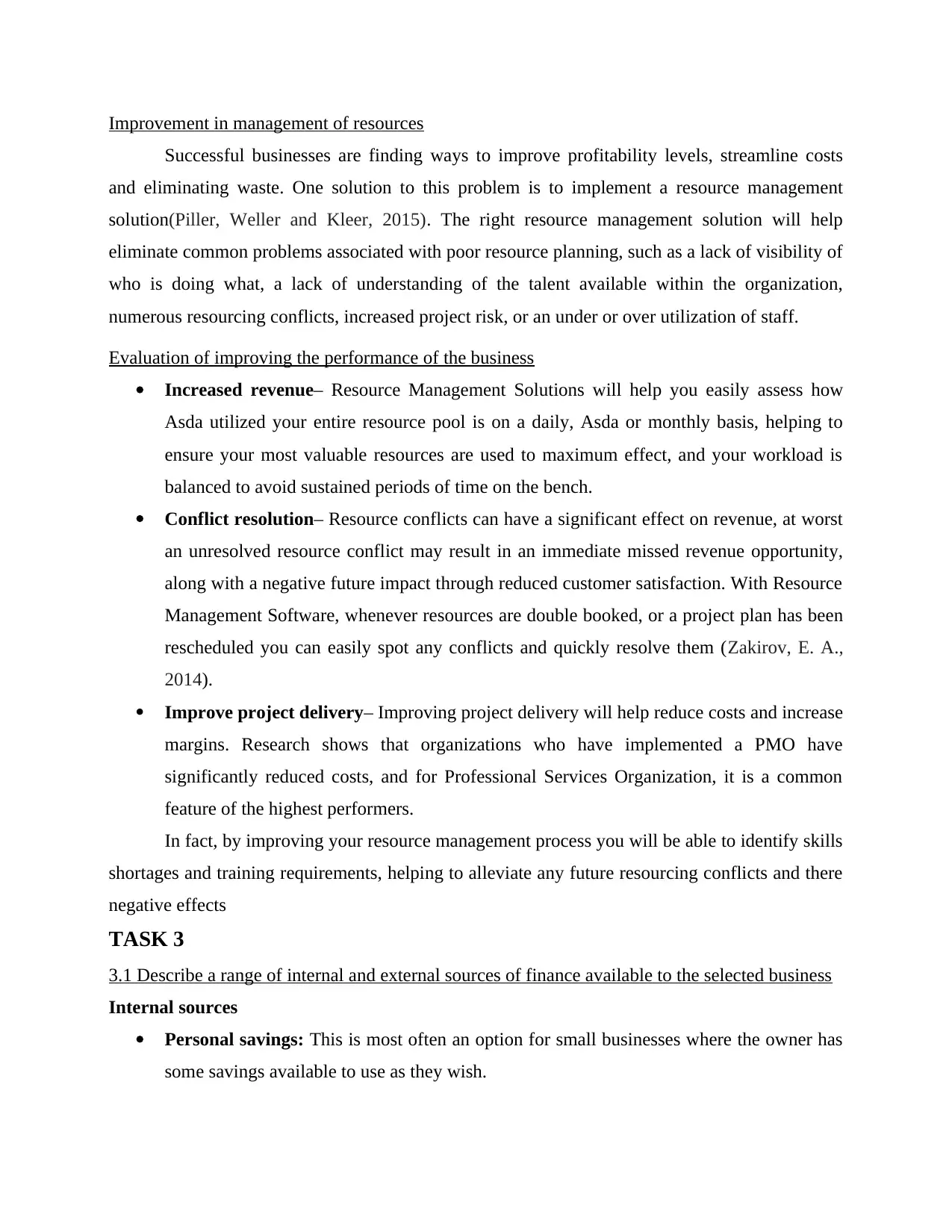
Improvement in management of resources
Successful businesses are finding ways to improve profitability levels, streamline costs
and eliminating waste. One solution to this problem is to implement a resource management
solution(Piller, Weller and Kleer, 2015). The right resource management solution will help
eliminate common problems associated with poor resource planning, such as a lack of visibility of
who is doing what, a lack of understanding of the talent available within the organization,
numerous resourcing conflicts, increased project risk, or an under or over utilization of staff.
Evaluation of improving the performance of the business
Increased revenue– Resource Management Solutions will help you easily assess how
Asda utilized your entire resource pool is on a daily, Asda or monthly basis, helping to
ensure your most valuable resources are used to maximum effect, and your workload is
balanced to avoid sustained periods of time on the bench.
Conflict resolution– Resource conflicts can have a significant effect on revenue, at worst
an unresolved resource conflict may result in an immediate missed revenue opportunity,
along with a negative future impact through reduced customer satisfaction. With Resource
Management Software, whenever resources are double booked, or a project plan has been
rescheduled you can easily spot any conflicts and quickly resolve them (Zakirov, E. A.,
2014).
Improve project delivery– Improving project delivery will help reduce costs and increase
margins. Research shows that organizations who have implemented a PMO have
significantly reduced costs, and for Professional Services Organization, it is a common
feature of the highest performers.
In fact, by improving your resource management process you will be able to identify skills
shortages and training requirements, helping to alleviate any future resourcing conflicts and there
negative effects
TASK 3
3.1 Describe a range of internal and external sources of finance available to the selected business
Internal sources
Personal savings: This is most often an option for small businesses where the owner has
some savings available to use as they wish.
Successful businesses are finding ways to improve profitability levels, streamline costs
and eliminating waste. One solution to this problem is to implement a resource management
solution(Piller, Weller and Kleer, 2015). The right resource management solution will help
eliminate common problems associated with poor resource planning, such as a lack of visibility of
who is doing what, a lack of understanding of the talent available within the organization,
numerous resourcing conflicts, increased project risk, or an under or over utilization of staff.
Evaluation of improving the performance of the business
Increased revenue– Resource Management Solutions will help you easily assess how
Asda utilized your entire resource pool is on a daily, Asda or monthly basis, helping to
ensure your most valuable resources are used to maximum effect, and your workload is
balanced to avoid sustained periods of time on the bench.
Conflict resolution– Resource conflicts can have a significant effect on revenue, at worst
an unresolved resource conflict may result in an immediate missed revenue opportunity,
along with a negative future impact through reduced customer satisfaction. With Resource
Management Software, whenever resources are double booked, or a project plan has been
rescheduled you can easily spot any conflicts and quickly resolve them (Zakirov, E. A.,
2014).
Improve project delivery– Improving project delivery will help reduce costs and increase
margins. Research shows that organizations who have implemented a PMO have
significantly reduced costs, and for Professional Services Organization, it is a common
feature of the highest performers.
In fact, by improving your resource management process you will be able to identify skills
shortages and training requirements, helping to alleviate any future resourcing conflicts and there
negative effects
TASK 3
3.1 Describe a range of internal and external sources of finance available to the selected business
Internal sources
Personal savings: This is most often an option for small businesses where the owner has
some savings available to use as they wish.
⊘ This is a preview!⊘
Do you want full access?
Subscribe today to unlock all pages.

Trusted by 1+ million students worldwide
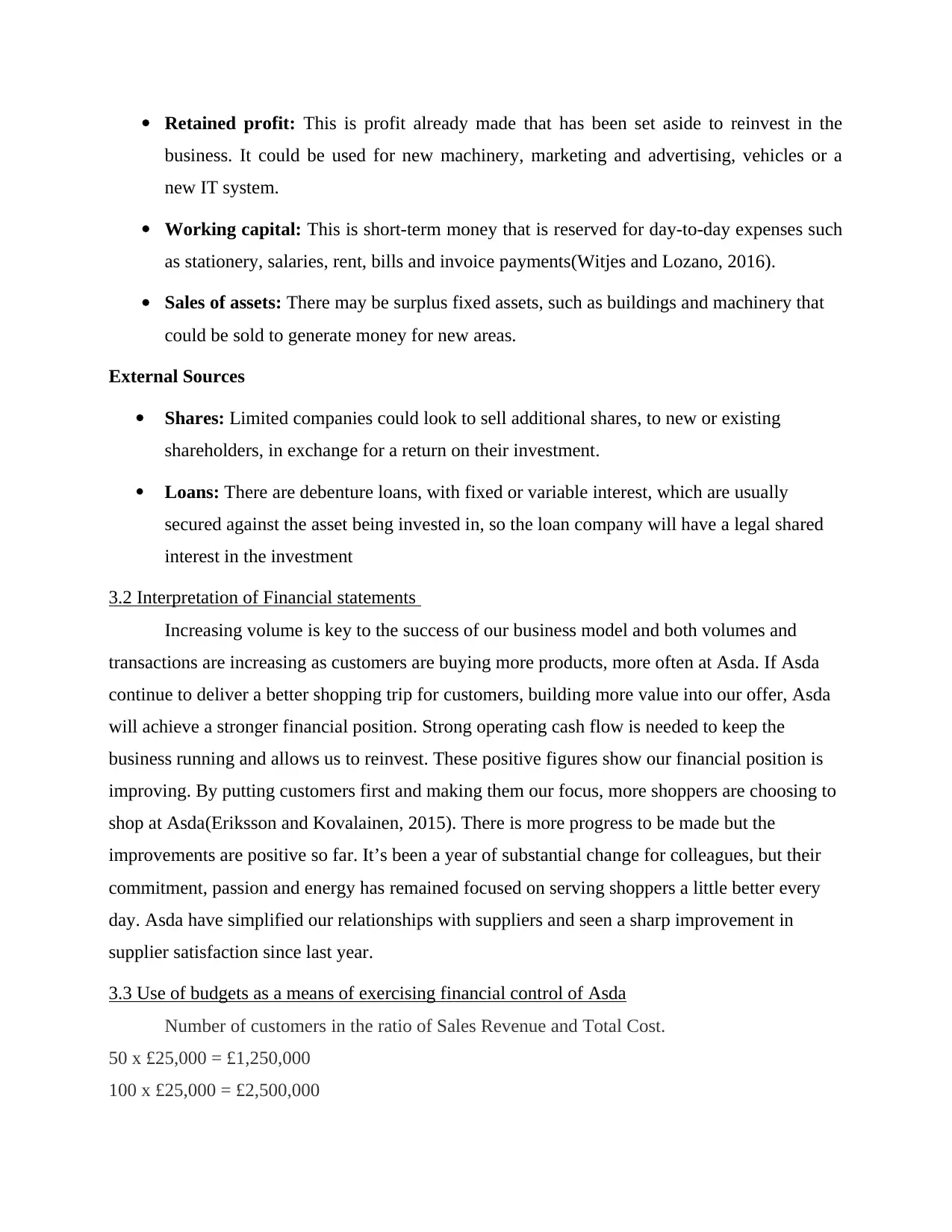
Retained profit: This is profit already made that has been set aside to reinvest in the
business. It could be used for new machinery, marketing and advertising, vehicles or a
new IT system.
Working capital: This is short-term money that is reserved for day-to-day expenses such
as stationery, salaries, rent, bills and invoice payments(Witjes and Lozano, 2016).
Sales of assets: There may be surplus fixed assets, such as buildings and machinery that
could be sold to generate money for new areas.
External Sources
Shares: Limited companies could look to sell additional shares, to new or existing
shareholders, in exchange for a return on their investment.
Loans: There are debenture loans, with fixed or variable interest, which are usually
secured against the asset being invested in, so the loan company will have a legal shared
interest in the investment
3.2 Interpretation of Financial statements
Increasing volume is key to the success of our business model and both volumes and
transactions are increasing as customers are buying more products, more often at Asda. If Asda
continue to deliver a better shopping trip for customers, building more value into our offer, Asda
will achieve a stronger financial position. Strong operating cash flow is needed to keep the
business running and allows us to reinvest. These positive figures show our financial position is
improving. By putting customers first and making them our focus, more shoppers are choosing to
shop at Asda(Eriksson and Kovalainen, 2015). There is more progress to be made but the
improvements are positive so far. It’s been a year of substantial change for colleagues, but their
commitment, passion and energy has remained focused on serving shoppers a little better every
day. Asda have simplified our relationships with suppliers and seen a sharp improvement in
supplier satisfaction since last year.
3.3 Use of budgets as a means of exercising financial control of Asda
Number of customers in the ratio of Sales Revenue and Total Cost.
50 x £25,000 = £1,250,000
100 x £25,000 = £2,500,000
business. It could be used for new machinery, marketing and advertising, vehicles or a
new IT system.
Working capital: This is short-term money that is reserved for day-to-day expenses such
as stationery, salaries, rent, bills and invoice payments(Witjes and Lozano, 2016).
Sales of assets: There may be surplus fixed assets, such as buildings and machinery that
could be sold to generate money for new areas.
External Sources
Shares: Limited companies could look to sell additional shares, to new or existing
shareholders, in exchange for a return on their investment.
Loans: There are debenture loans, with fixed or variable interest, which are usually
secured against the asset being invested in, so the loan company will have a legal shared
interest in the investment
3.2 Interpretation of Financial statements
Increasing volume is key to the success of our business model and both volumes and
transactions are increasing as customers are buying more products, more often at Asda. If Asda
continue to deliver a better shopping trip for customers, building more value into our offer, Asda
will achieve a stronger financial position. Strong operating cash flow is needed to keep the
business running and allows us to reinvest. These positive figures show our financial position is
improving. By putting customers first and making them our focus, more shoppers are choosing to
shop at Asda(Eriksson and Kovalainen, 2015). There is more progress to be made but the
improvements are positive so far. It’s been a year of substantial change for colleagues, but their
commitment, passion and energy has remained focused on serving shoppers a little better every
day. Asda have simplified our relationships with suppliers and seen a sharp improvement in
supplier satisfaction since last year.
3.3 Use of budgets as a means of exercising financial control of Asda
Number of customers in the ratio of Sales Revenue and Total Cost.
50 x £25,000 = £1,250,000
100 x £25,000 = £2,500,000
Paraphrase This Document
Need a fresh take? Get an instant paraphrase of this document with our AI Paraphraser
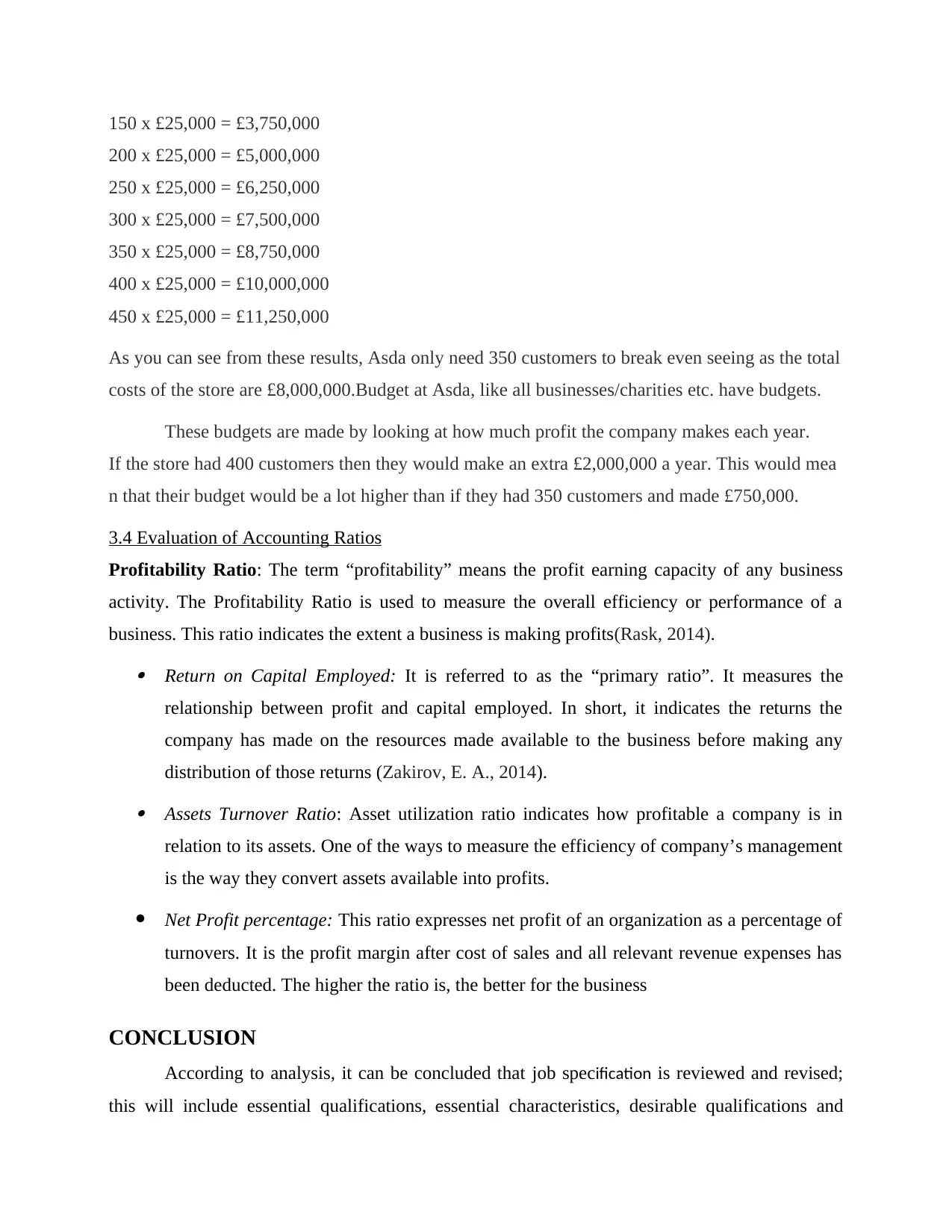
150 x £25,000 = £3,750,000
200 x £25,000 = £5,000,000
250 x £25,000 = £6,250,000
300 x £25,000 = £7,500,000
350 x £25,000 = £8,750,000
400 x £25,000 = £10,000,000
450 x £25,000 = £11,250,000
As you can see from these results, Asda only need 350 customers to break even seeing as the total
costs of the store are £8,000,000.Budget at Asda, like all businesses/charities etc. have budgets.
These budgets are made by looking at how much profit the company makes each year.
If the store had 400 customers then they would make an extra £2,000,000 a year. This would mea
n that their budget would be a lot higher than if they had 350 customers and made £750,000.
3.4 Evaluation of Accounting Ratios
Profitability Ratio: The term “profitability” means the profit earning capacity of any business
activity. The Profitability Ratio is used to measure the overall efficiency or performance of a
business. This ratio indicates the extent a business is making profits(Rask, 2014). Return on Capital Employed: It is referred to as the “primary ratio”. It measures the
relationship between profit and capital employed. In short, it indicates the returns the
company has made on the resources made available to the business before making any
distribution of those returns (Zakirov, E. A., 2014). Assets Turnover Ratio: Asset utilization ratio indicates how profitable a company is in
relation to its assets. One of the ways to measure the efficiency of company’s management
is the way they convert assets available into profits.
Net Profit percentage: This ratio expresses net profit of an organization as a percentage of
turnovers. It is the profit margin after cost of sales and all relevant revenue expenses has
been deducted. The higher the ratio is, the better for the business
CONCLUSION
According to analysis, it can be concluded that job specification is reviewed and revised;
this will include essential qualifications, essential characteristics, desirable qualifications and
200 x £25,000 = £5,000,000
250 x £25,000 = £6,250,000
300 x £25,000 = £7,500,000
350 x £25,000 = £8,750,000
400 x £25,000 = £10,000,000
450 x £25,000 = £11,250,000
As you can see from these results, Asda only need 350 customers to break even seeing as the total
costs of the store are £8,000,000.Budget at Asda, like all businesses/charities etc. have budgets.
These budgets are made by looking at how much profit the company makes each year.
If the store had 400 customers then they would make an extra £2,000,000 a year. This would mea
n that their budget would be a lot higher than if they had 350 customers and made £750,000.
3.4 Evaluation of Accounting Ratios
Profitability Ratio: The term “profitability” means the profit earning capacity of any business
activity. The Profitability Ratio is used to measure the overall efficiency or performance of a
business. This ratio indicates the extent a business is making profits(Rask, 2014). Return on Capital Employed: It is referred to as the “primary ratio”. It measures the
relationship between profit and capital employed. In short, it indicates the returns the
company has made on the resources made available to the business before making any
distribution of those returns (Zakirov, E. A., 2014). Assets Turnover Ratio: Asset utilization ratio indicates how profitable a company is in
relation to its assets. One of the ways to measure the efficiency of company’s management
is the way they convert assets available into profits.
Net Profit percentage: This ratio expresses net profit of an organization as a percentage of
turnovers. It is the profit margin after cost of sales and all relevant revenue expenses has
been deducted. The higher the ratio is, the better for the business
CONCLUSION
According to analysis, it can be concluded that job specification is reviewed and revised;
this will include essential qualifications, essential characteristics, desirable qualifications and
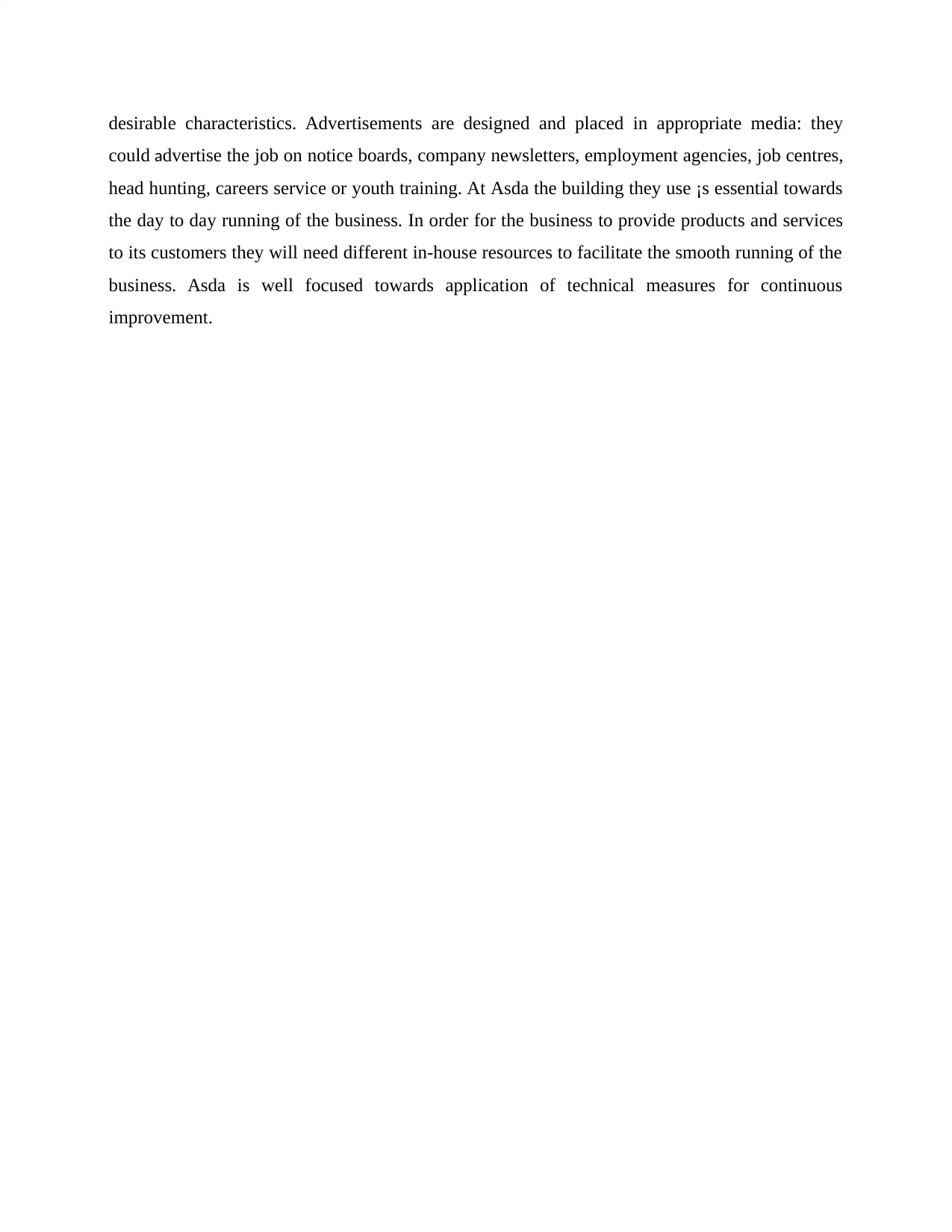
desirable characteristics. Advertisements are designed and placed in appropriate media: they
could advertise the job on notice boards, company newsletters, employment agencies, job centres,
head hunting, careers service or youth training. At Asda the building they use ¡s essential towards
the day to day running of the business. In order for the business to provide products and services
to its customers they will need different in-house resources to facilitate the smooth running of the
business. Asda is well focused towards application of technical measures for continuous
improvement.
could advertise the job on notice boards, company newsletters, employment agencies, job centres,
head hunting, careers service or youth training. At Asda the building they use ¡s essential towards
the day to day running of the business. In order for the business to provide products and services
to its customers they will need different in-house resources to facilitate the smooth running of the
business. Asda is well focused towards application of technical measures for continuous
improvement.
⊘ This is a preview!⊘
Do you want full access?
Subscribe today to unlock all pages.

Trusted by 1+ million students worldwide
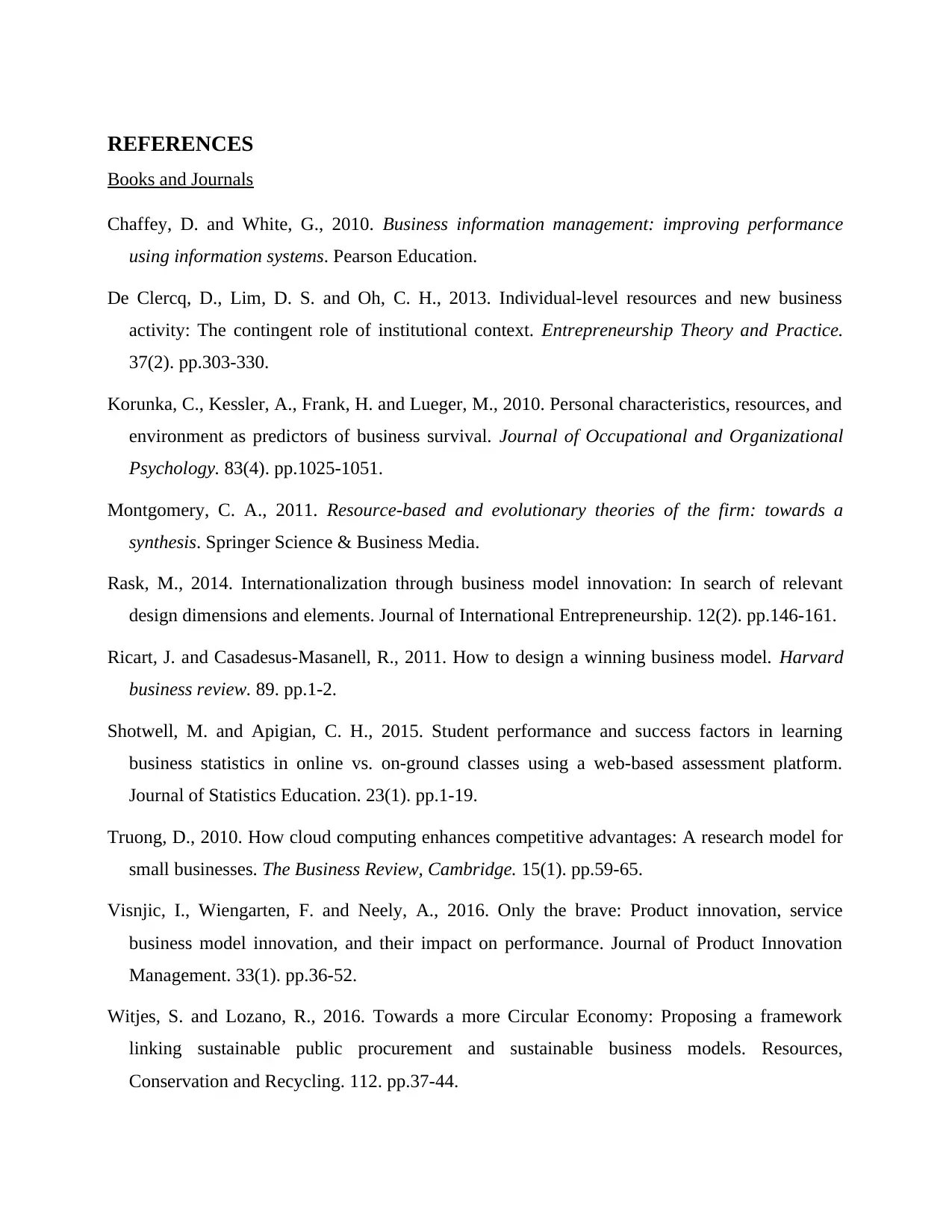
REFERENCES
Books and Journals
Chaffey, D. and White, G., 2010. Business information management: improving performance
using information systems. Pearson Education.
De Clercq, D., Lim, D. S. and Oh, C. H., 2013. Individual‐level resources and new business
activity: The contingent role of institutional context. Entrepreneurship Theory and Practice.
37(2). pp.303-330.
Korunka, C., Kessler, A., Frank, H. and Lueger, M., 2010. Personal characteristics, resources, and
environment as predictors of business survival. Journal of Occupational and Organizational
Psychology. 83(4). pp.1025-1051.
Montgomery, C. A., 2011. Resource-based and evolutionary theories of the firm: towards a
synthesis. Springer Science & Business Media.
Rask, M., 2014. Internationalization through business model innovation: In search of relevant
design dimensions and elements. Journal of International Entrepreneurship. 12(2). pp.146-161.
Ricart, J. and Casadesus-Masanell, R., 2011. How to design a winning business model. Harvard
business review. 89. pp.1-2.
Shotwell, M. and Apigian, C. H., 2015. Student performance and success factors in learning
business statistics in online vs. on-ground classes using a web-based assessment platform.
Journal of Statistics Education. 23(1). pp.1-19.
Truong, D., 2010. How cloud computing enhances competitive advantages: A research model for
small businesses. The Business Review, Cambridge. 15(1). pp.59-65.
Visnjic, I., Wiengarten, F. and Neely, A., 2016. Only the brave: Product innovation, service
business model innovation, and their impact on performance. Journal of Product Innovation
Management. 33(1). pp.36-52.
Witjes, S. and Lozano, R., 2016. Towards a more Circular Economy: Proposing a framework
linking sustainable public procurement and sustainable business models. Resources,
Conservation and Recycling. 112. pp.37-44.
Books and Journals
Chaffey, D. and White, G., 2010. Business information management: improving performance
using information systems. Pearson Education.
De Clercq, D., Lim, D. S. and Oh, C. H., 2013. Individual‐level resources and new business
activity: The contingent role of institutional context. Entrepreneurship Theory and Practice.
37(2). pp.303-330.
Korunka, C., Kessler, A., Frank, H. and Lueger, M., 2010. Personal characteristics, resources, and
environment as predictors of business survival. Journal of Occupational and Organizational
Psychology. 83(4). pp.1025-1051.
Montgomery, C. A., 2011. Resource-based and evolutionary theories of the firm: towards a
synthesis. Springer Science & Business Media.
Rask, M., 2014. Internationalization through business model innovation: In search of relevant
design dimensions and elements. Journal of International Entrepreneurship. 12(2). pp.146-161.
Ricart, J. and Casadesus-Masanell, R., 2011. How to design a winning business model. Harvard
business review. 89. pp.1-2.
Shotwell, M. and Apigian, C. H., 2015. Student performance and success factors in learning
business statistics in online vs. on-ground classes using a web-based assessment platform.
Journal of Statistics Education. 23(1). pp.1-19.
Truong, D., 2010. How cloud computing enhances competitive advantages: A research model for
small businesses. The Business Review, Cambridge. 15(1). pp.59-65.
Visnjic, I., Wiengarten, F. and Neely, A., 2016. Only the brave: Product innovation, service
business model innovation, and their impact on performance. Journal of Product Innovation
Management. 33(1). pp.36-52.
Witjes, S. and Lozano, R., 2016. Towards a more Circular Economy: Proposing a framework
linking sustainable public procurement and sustainable business models. Resources,
Conservation and Recycling. 112. pp.37-44.
1 out of 10
Related Documents
Your All-in-One AI-Powered Toolkit for Academic Success.
+13062052269
info@desklib.com
Available 24*7 on WhatsApp / Email
![[object Object]](/_next/static/media/star-bottom.7253800d.svg)
Unlock your academic potential
Copyright © 2020–2025 A2Z Services. All Rights Reserved. Developed and managed by ZUCOL.





